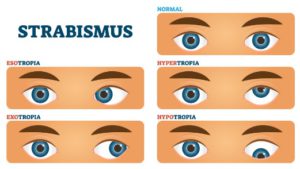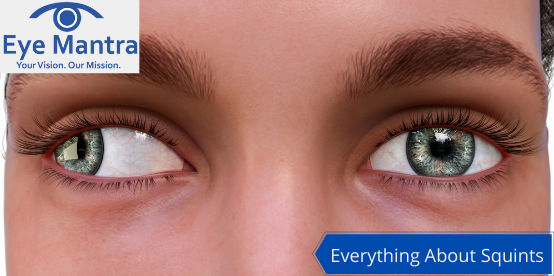Contents
What is Squint?
A squint, also called “strabismus”, is a condition wherein both the eyes are unable to align properly. One eye turns inside, upside, downwards, or outwards, while the other one focuses on one point. It can happen every time or at regular intervals as well. This takes place because the muscles that control the movement of the eye and the eyelid ( called the extraocular muscles) are not working together.
As a result, both eyes fail to focus at the same spot at the same time. It can also occur due to a disorder in the brain that further means eyes cannot correctly coordinate. Strabismus also makes binocular vision impossible, so it is difficult for the person to identify depth perception.
Strabismus most often hits babies and toddlers due to heredity or problems during physical development after birth. Most cases in children are caused because of poor communication between the brain, muscles, and nerves of the eye. However, it can also happen to adults who have faced a stroke, head trauma or are suffering from diabetes. The situation can result in double vision, a lack of depth perception, and even loss of eyesight if left untreated.
Category of Squint based on Misalignment
- Hypertropia is a condition of misalignment of eyes where the optical axis of one eye is higher than the other fixating eye. The dissociated vertical deviation is a type of hypertropia that leads to slow upward drift of one or sometimes both eyes, usually when the patient is inattentive.
- Hypotropia is the condition where the focus is on the eye with the optical axis lower than the other fixating eye.
- Esotropia is a form of strabismus wherein one or sometimes both eyes turn towards the inner. The condition can be present throughout, or occur at regular intervals, and can give the affected individual a ‘cross-eyed’ appearance.
- Exotropia is when one or both eyes turn outward. Exotropia may occur from time to time or maybe constant and can be found in every age group.
Types of Strabismus
There are several forms of strabismus. The two most common are:
- Accommodative Esotropia: This often occurs when farsightedness is left uncorrected and also because of family history. The ability to focus is linked to where the eyes are pointing, because of which the extra focusing effort needed to keep far away objects in clear focus may cause the eyes to turn inward. Symptoms of such conditions include double vision, closing or covering one eye when looking at something near, and tilting or turning the head. Such condition of strabismus usually starts in the first few years of life. And this condition is usually treated with glasses, but may also require eye patching and/or surgery on the muscles of one or both eyes.
- Intermittent Exotropia: In this type of strabismus, one eye gets fixated (concentrated) on a target while the other eye is pointing outward. Symptoms may include double vision, headaches, difficulty reading, eyestrain, and closing one eye when viewing far-away objects or when in bright light. Patients may have no symptoms while the ocular deviation (difference) may be noticed by others. Intermittent Exotropia can happen at any age. Treatment may involve glasses, patching, eye exercises, and/or surgery on the muscles of one or both eyes.
Causes of Squint or Strabismus
Most adults are found to have the problem of squint since their childhood. However, strabismus can also begin in adulthood due to medical problems. Most squints are the result of a malformation of the neuromuscular control of eye movement. Sometimes it is noticed that there is a problem with the actual eye muscle. It is often witnessed that squint is inherited, and about 30 percent of children with strabismus have a family member with a similar problem.
Other conditions associated with strabismus include:
- Uncorrected refractive errors.
- Poor vision in one eye.
- Cerebral palsy.
- Down syndrome (20-60% of these patients are affected).
- Hydrocephalus (a congenital disease that results in a build-up of fluid in the brain).
- Brain tumors.
- Stroke (the leading cause of strabismus in adults)
- Head injuries, which can damage the area of the brain responsible for the control of eye movement, the nerves that control eye movement, and the eye muscles.
- Neurological (nervous system) problems.
- Graves’ disease (overproduction of thyroid hormone).
Symptoms of Strabismus

Adults with squints may experience:
- Eye fatigue.
- Double vision
- Overlapped or blurred images.
- A pulling sensation around the eyes.
- Reading difficulty.
- Loss of depth perception.
- Inability to make direct contact while communicating or looking at people with both eyes.
To rectify the inability to focus properly, many adults with squints have to tilt or turn their heads when focusing. They also face trouble making direct eye contact with both eyes when looking at people, which can make time feel awkward in social situations.
These symptoms may have a negative impact on employment and social opportunities.
Treatment of Squint or Strabismus
Treatment options include the following:
- Eyeglasses or contact lenses: These are used by people with uncorrected refractive errors. With remedial lenses, the eyes will not have to put that much effort into focusing and can stay straight.
- Prism lenses: These are the special lenses that help the light to bend and enter the eye and further help in reducing the amount of turning the eye must do to look at objects.
- Orthoptics (eye exercises): May work on some types of strabismus, especially convergence insufficiency (a form of Exotropia).
- Medications: Eye drops or ointments. Also, injections of botulinum toxin type A (such as Botox) can weaken an overactive eye muscle. These treatments may be used with, or as a substitute for surgery, depending on the patient’s situation.
- Patching: To treat amblyopia (lazy eye), when the patient is suffering from both amblyopia and strabismus at the same time. The improvement of vision also can control the misalignment of the eye.
- Eye muscle surgery: Surgery changes the length or size of eye muscles so that the eyes are aligned properly. This is performed under general anesthesia with stitches that get dissolved with time. Sometimes adults are provided with adjustable strabismus surgery, where the eye muscle positions are adjusted after surgery.
Untreated Strabismus
If the eyes are not properly aligned, it may result in the following:
- Lazy eye (amblyopia), or permanent vision problem in the turned eye. When your eyes are looking in different directions, the brain receives two images. To avoid double vision, the brain may ignore the image from the turned eye, resulting in an increase of poor vision in an eye.
- Blurry vision, which can affect your performance at every point, and obstruct your ways of enjoyment and leisure activities.
- Increased eye strain.
- Eye Fatigue.
- Frequent Headaches.
- The appearance of Double vision.
- Poor 3-dimensional (3-D) vision.
Benefits of squint surgery
- Improved appearance (often)
- Increased peripheral (side) vision
- Improved depth perception (sometimes)
Exercises for the treatment of squint or strabismus
Pencil push-ups
Pencil push-ups are simple workouts for oculars progress that get both eyes directed at the same fixed point. They are also called by the other name which is near the point of convergence exercises.
Hold a pencil out at arm’s length, pointing away from you. Focus your sight on the eraser or a letter/numeral on the side. Slowly bring the pencil closer toward the bridge of the nose. Keep it in focus for as long as you can, but you need to stop once your vision gets blurry.
Brock string
Swiss optometrist Frederick Brock came up with this exercise to improve eye coordination. You need to have a string about 5 feet long with three different coloured beads.
Secure one end of the string to a fixated point such as a handrail or at the back of a chair. Space the beads out at equal distances. Keep holding the other end of the string firmly to your nose. You should be noticing a consistent pattern as you shift your focus from bead to bead. The bead you are looking at will appear by itself at the convergence of two identical strings with doubles of the other beads, forming an X. Your eyes are not properly focused on the bead if you see the strings crossing in front of the bead or in the back of the bead. Make sure that you are getting the X at all beads (except the one at the far end, which will just have the two strings coming out toward you in a V).
Barrel cards
This is a handy exercise for Exotropia. Draw three barrels of increasing size in red lengthwise on one side of a card. Repeat the same thing in green on the other side.
Hold the card lengthwise and vertically against your nose in such a way that the largest barrel is furthest away. Stare at the far barrel until it becomes one image with both colours and the other two barrel images have doubled. Maintain your gaze for about five seconds. Then do the same with the middle and smallest barrel images.
There are various eye hospitals in Delhi, you can visit and get the best treatment.
If you are also encouraged by the benefits of eye exams do visit us. To understand more about healthy eyes tips, you can simply visit our website Eyemantra. Our expert guides will give details of all service in a descriptive manner that are present with us. We render services like Glaucoma surgery, cataract surgery, Retina surgery, Low Vision Aids or Ocuploplasty you can simply call us at +91-9711115191. Even you can mail us on [email protected].
Book your online appointments and get the best services at a valuable price.
Realted articles
Do’s and Dont’s for protecting your eyes while playing Holi
A Complete Guide Children’s Eye Diseases and their Treatments



